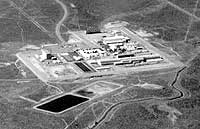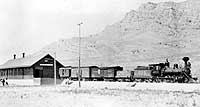

Atomic
City
There
was a great influx of settlers to the Furrey (midway) area between 1910 and
1920. Every tillable acre was taken. A wet period ended about 1919, and wheat
prices plummeted. Most of the homestead land was abandoned. After the "National
Reactor Testing Station" (NRTS) was begun in the desert to the north, a
flurry of excitement caused local boosters to extol the virtues and growth possibilities
of the town and to rename it Atomic City, but its remote location and lack of
amenities caused the boom to bust.
Idaho
National Engineering & Environmental Laboratory
The Idaho
National Engineering Laboratory (INEEL) was established as the Nuclear Reactor
Testing Station in 1949. The INEEL site is 890 square miles of sagebrush desert,
and contains large areas of young basalt lava flows as well as East and Middle
(or Twin) Buttes, which are small rhyolite domes. It is the site of secret activities
related to nuclear research. It is also a land of acronyms (cFA, RWMC, TAN,
SPERT, NRF, and etc.) The "Site" first generated electricity with
nuclear reactors in 1951. In 1955 Arco became the first town in the United States
lighted by nuclear power. In 1992, the INEEL employed about 10,000 people, providing
almost 5% of the jobs in Idaho; it is the mainstay of the economy of Idaho Falls
area. The INEEL budget, in 1987, was $800 million, two-thirds as large as the
budget for the state of Idaho ($1.2 billion).
It is ironic that this politically conservative and philosophically independent region, most of whose legislators are perennially distrustful of Federal Government programs and always opposed to any increase in taxes, is largely subsidized by Federal tax dollars raised mainly in other states.
| Schematic cross section along the axial volcanic zone of the eastern Snake River Plain, showing the ages, rock types, and known or inferred relationships of Pleistocene silicic volcanic domes. Neogene = 35 to 2 million years old, Pleistocene = less than 2 million years old. Ka = thousand years old. Rhyolite, trachyte, trachyandesite rocks, and basalt are volcanic rock types, redrawn from Hackett and Smith (1992). |